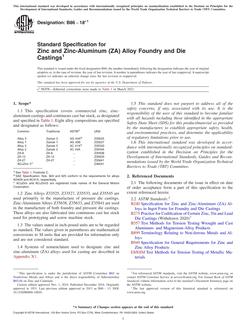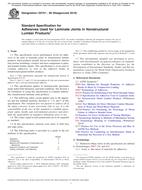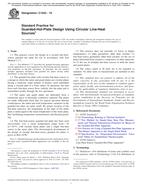1.1 This practice covers a high-pressure, high-temperature digestion technique using the high-pressure asher (HPA) for preparation of oils and oily waste specimens for determination of up to 28 different elements by inductively coupled plasma-atomic emission plasma spectroscopy (ICP-AES), cold-vapor atomic absorption spectroscopy (CVAAS), and graphite furnace atomic absorption spectroscopy (GFAAS), inductively coupled plasma-mass spectrometry (ICPMS), and radiochemical methods. Oily and high-percentage organic waste streams from nuclear and non-nuclear manufacturing processes can be successfully prepared for trace element determinations by ICP-AES, CVAAS, and GFAAS. This practice is applicable to the determination of total trace elements in these mixed wastes. Specimens prepared by this practice can be used to characterize organic mixed waste streams received by hazardous waste treatment incinerators and for total element characterization of the waste streams.
1.2 This practice is applicable only to organic waste streams that contain radioactivity levels that do not require special personnel or environmental protection from radioactivity or other acute hazards.
1.3 A list of elements determined in oily waste streams is found in Table 1.
1.4 This practice has been used successfully to completely digest a large variety of oils and oily mixed waste streams from nuclear processing facilities. While the practice has been used to report data on up to 28 trace elements, its success should not be expected for all analytes in every specimen. The overall nature of these oily wastes tends to be heterogeneous that can affect the results. Homogeneity of the prepared sample is critical to the precision and quality of the results.
1.5 This practice is designed to be applicable to samples whose preparation practices are not defined, or not suitable, by other regulatory procedures or requirements, such as the U.S. Environmental Protection Agency (EPA) SW-846 and EPA-600/4-79-020 documents. This digestion practice is designed to provide a high level of accuracy and precision, but does not replace or override any regulatory requirements for sample preparation.
1.6 This practice uses hazardous materials, operations, and equipment at high pressure (90–110 bars, 89–108 atm, or 1305–1595 lb/in.²) and high temperatures, up to 320°C, and therefore poses significant hazards if not operated properly.
1.7 The values stated in SI units are to be regarded as standard. No other units of measurement are included in this standard.
1.7.1 Exception – Pressure measurements are given in lb/in. units.
1.8 This standard does not purport to address all of the safety concerns, if any, associated with its use. It is the responsibility of the user of this standard to establish appropriate safety and health practices and determine the applicability of regulatory limitations prior to use. Specific warning statements are given in Sections 10.
TABLE 1 List of Elements and Applicable Lower Concentration Ranges
| Element | Lower Reportable Limit,A μg/g |
Analysis Method |
|---|---|---|
| Aluminum | 3.3 | ICP-AES |
| Antimony | 8.3 | ICP-AES or GFAAS |
| Arsenic | 8.3 | ICP-AES or GFAAS |
| Barium | 0.17 | ICP-AES |
| Beryllium | 0.05 | ICP-AES |
| Boron | 0.67 | ICP-AES |
| Cadmium | 0.50 | ICP-AES or GFAAS |
| Calcium | 0.67 | ICP-AES |
| Chromium | 1.7 | ICP-AES |
| Cobalt | 0.83 | ICP-AES |
| Copper | 0.67 | ICP-AES |
| Iron | 0.67 | ICP-AES |
| Lead | 8.3 | ICP-AES or GFAAS |
| Lithium | 0.67 | ICP-AES |
| Magnesium | 0.08 | ICP-AES |
| Manganese | 0.17 | ICP-AES |
| Mercury | 0.03 | CVAAS |
| Nickel | 1.7 | ICP-AES |
| Potassium | 100 | ICP-AES |
| Selenium | 8.3 | ICP-AES or GFAAS |
| Silver | 1.0 | ICP-AES |
| Sodium | 3.3 | ICP-AES |
| Strontium | 0.07 | ICP-AES |
| Thallium | 1.7 | GFAAS |
| Titanium | 0.50 | ICP-AES |
| Vanadium | 0.83 | ICP-AES |
| Zinc | 0.17 | ICP-AES |
| Zirconium | 0.83 | ICP-AES |
A Lower reportable limits are based on a 0.3-g sample diluted to a final volume of 50 mL. These limits should only be used as a guide. Actual values are instrument and sample dependent.
Product Details
- Published:
- 06/01/2011
- Number of Pages:
- 5
- File Size:
- 1 file , 110 KB
- Redline File Size:
- 2 files , 210 KB


